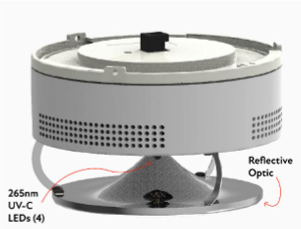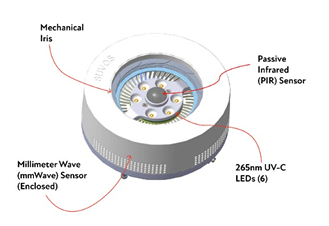Advanced In-Room Disinfection for Dental Operatories, Patient Areas, and Reception
Prepared by Dr. Scott Trettenero, DDS and Dr. Kris Belland, DO, MBA, MPH
1 July, 2025
AEROCLENZ.COM | 38 MILDRED DRIVE, FORT MYERS, FL 33901 | O: 239.296.9193
Introduction
The AeroClenz AdaptUV System offers dentistry the most advanced, efficient, and cost effective airborne and surface disinfection technology available in today’s market. Healthy dental environments are greatly enhanced by UV-C LED disinfection, minimizing exposure to pathogens (including viruses, bacteria, spores, and fungi). The AdaptUV System adds one more proven effective layer in the fight to reduce the risk of infection from airborne and surface pathogens.
AdaptUV System contains multiple product solutions, utilizing a mix of targeted air & surface disinfection and continuous upper room disinfection, which safely disinfect the dental office’s air and surfaces in both occupied and unoccupied spaces. The addition of this state-of-the art disinfection capability will provide value and confidence to patients and helps to reduce dependency on costly, environmentally abrasive, and time-consuming chemical disinfection procedures.
The AdaptUV System is designed to effectively inactivate (or kill) or stop replication of airborne and surfaceborne pathogens with devices that offer the most advanced and effective airborne and surface disinfection of viruses, bacteria, spores, and fungi. Devices are custom configured for each installation and use advanced UV-C light to actively inactivate pathogens close to their point of origin (e.g., exhalation and aerosols from an infectious patient and surfaces).
UV-C disinfection has been increasingly utilized as a tool to reduce the spread of infectious agents, both on surfaces and in the air. Existing studies point to UV-C’s ability to potentially lower infection rates, cut healthcare costs, and keep workforces healthy.
AeroClenz’s breakthroughs in UV-C LED technology have created opportunities for dental professionals to upgrade their fight against airborne pathogens, protect office staff, as well as providing enhanced surface disinfection capabilities. These breakthroughs have the potential to bring a new dimension of disinfection that will add an additional layer of protection for office staff and patients.
Background of UV-C
Ultraviolet germicidal irradiation (UVGI) has long been established as a means of disinfection and prevention of the spread of many infectious diseases (i.e. Tuberculosis, Common Colds, Influenza, Bacterial Meningitis to name a few).1 UV-C irradiation kills or inactivates microbes by damaging their DNA/RNA.2
Researchers recognized the impact of light on microorganisms as early as 1845, with a breakthrough in 1877 showing sunlight inhibited microorganism growth in Pasteur’s solution.3 Studies later found shorter wavelengths to be most effective. In 1933, the concept of airborne infection via droplet nuclei emerged, and by 1935, experiments confirmed ultraviolet germicidal irradiation (UVGI) deactivated airborne microorganisms.4 The 1960s and 1970s saw the introduction of upper-room UVGI, followed by extensive efforts in the 1990s to evaluate its efficacy and safety.
UV-C light has long been used for water treatment and air disinfection, including during World War II for disinfecting hospitals and military facilities. Advancements in the 1950s boosted its accessibility, leading to widespread adoption today for decontamination. UV-C supplements other disinfection methods by neutralizing bacteria, viruses, and pathogens.5
AeroClenz UV-C LED Advancements
AeroClenz utilizes proprietary UV-C LEDs which improve efficiency, safety, ease of installation, and significantly lower costs compared to existing modalities.6 The latest systematic review of available research has shown that UV-C LEDs are equal or more efficient and effective in both air and surface disinfection than traditional UV lamps.7
Advancements in UV-C LED technology are obsoleting expensive and potentially dangerous mercury (Hg) vapor UV-C bulbs. Since the convergence of the Minamata Convention on Mercury, these bulbs are being phased out or banned completely in many countries and US states, as mercury is a known toxic material.8
Although it’s been proven to be highly effective, UVGI usage has been limited in scope because human exposure over threshold limits (TLV) to UV-C radiation can cause photokeratitis and dermatitis (sunburn) and if high enough dose, for long enough can increase the chance of some forms of non-melanoma skin cancer.9 Hg bulbs are expensive, fragile, energy inefficient, and have short operating lifetimes.
Currently, there are a few applications where some dental offices are using UVGI in enclosed air conditioning HVAC units, self-contained air disinfection floor “cabinet” units, robotic UV-C disinfection systems, and self-contained wall or ceiling mounted UV-C fixtures for disinfection.
Recent developments in ultraviolet-C bandwidth LEDs have opened the doors to more widespread usage.10 This unleashes an untapped market for air and surface disinfection which can have a profound impact on making our indoor environments cleaner and safer.
UV-C LED light provides several synergistic advantages over traditional methods, including rapid, residue-free disinfection of airborne and surface pathogens. It can be automated to reduce human error and disinfect the dental environment in minutes, improving efficiency. UV-C light acts immediately and is effective against a broad spectrum of viruses, including many known human pathogens, by damaging their genetic material (DNA or RNA). UV-C light effectively inactivates / kills microorganisms by damaging their DNA or RNA, preventing replication, and it is effective against bacteria, viruses, and fungi. Studies show UV-C can significantly reduce airborne pathogens
Bolb Inc., a semiconductor manufacturer out of Livermore California, has solved many of the technological challenges that have led to a dramatic increase in improved performance and reduced costs of UV-C LEDs.11 12 Their proprietary science has the potential to usher in game changing applications for health and safety, similar to how conventional LED lighting has taken over the illumination market.
The AeroClenz AdaptUV System
AdaptUV currently features a layered dual system approach – Continuous upper room air disinfection and targeted air & surface disinfection.
Upper room disinfection devices clean and disinfect the air above our heads with the natural flow of air convection. Airflow convection refers to the transfer of heat due to temperature differences. Warm air, contaminated by people breathing, speaking, coughing, sneezing, etc., rises and will be disinfected continuously. HVAC produces cooler air which will be cleaned by the upper room UV-C Led device. This disinfected air will sink, providing a constant source of fresh, clean air.

This is especially needed in high traffic areas where the rooms are constantly occupied such as waiting areas, front desk spaces, hallways and such. This is vitally important in clinical areas as aerosol spray from handpieces and ultrasonics produce contaminated air from infected patients. The frequent generation of pathogenic aerosols from high-speed handpieces and ultrasonic cleaners contaminate the air and can last for hours. Continuous upper room disinfection is a solution to this problem.
Our targeted air & surface disinfection devices utilize 6 powerful, yet safe UV-C LEDs to provide a targeted cone of disinfection. Anything the light reaches is disinfected. These proprietary devices are now equipped with internal human presence sensors making them safe, effective, and efficient. The newest advancements have advantages over chemical disinfectants and other conventional disinfection procedures improving hygiene and environmental sustainability and reducing risk with triple redundant and fail-safe engineered systems.

Millimeter Wave (mmWave)
This product solution device that makes up the AdaptUV system incorporates millimeter wave radar sensors (mmWave) operating at 24 GHz, providing highly accurate and reliable detection of human presence within its disinfection range. MmWave sensors emit high-frequency electromagnetic waves and measure the time it takes for these signals to reflect after hitting an object, providing precise detection and ranging of objects. This sensing technology continuously monitors spaces, ensuring UV-C LEDs are automatically deactivated, and the mechanical iris is safely closed when humans or pets are detected.
With a wide detection field of view, the mmWave efficiently recognize both stationary and moving individuals, significantly enhancing the safety and effectiveness of disinfection processes in dental settings.
Passive Infrared (PIR) Sensor
In addition to mmWave sensing, the device also features a Passive Infrared (PIR) sensor. PIR sensors detect infrared radiation emitted naturally by all humans and animals, by sensing changes in heat signatures within their detection zone. This dual sensor approach ensures redundancy and increases reliability in human presence detection. The PIR sensor effectively complements the mmWave system by detecting thermal radiation emitted by humans, disabling UV-C operation when individuals approach within its 2-meter direct-detection range.
Together, the mmWave and PIR sensors create a highly responsive, safe, and intelligent device capable of dynamically adapting its operation based on human activity. The device operates in distinct modes. It enters disinfection mode when no human or animal presence is detected, opening the mechanical iris and activating the UV-C LEDs for a predefined disinfection cycle, lasting a full uninterrupted 10 minutes. Upon completion of the cycle, it transitions to standby mode, with the iris safely closed, until a human presence is again detected. This intelligent mode-switching ensures optimal disinfection efficiency while prioritizing safety, energy efficiency, and comfort for dental office patients, staff, and owners.
Manual cleaning with chemical disinfectants effectively reduces surface contamination but has limitations, including variability in thoroughness, recontamination risks, and potential environmental and toxic effects. Additionally, proper contact or “dwell time” is crucial for efficacy, as insufficient contact time can leave pathogens behind and potentially spread infections.
Future Scope for Dental Disinfection
The ramification of this technology is far reaching. This new synergistic system, working with already in place risk mitigation systems can make any dental office a much cleaner and safer environment for patients and staff with its air and surface disinfection.13 Until now, disinfection of airborne pathogens in the dental office has hit a plateau, until UV-C LED systems have come along.14 Older technologies like HEPA filters have been used to effectively capture particles however, their efficiency depends on airflow, leaving areas of reduced circulation at higher risk. Studies confirm that airborne transmission risks persist even with the use of HEPA filtration systems. AdaptUV technologies help to fill this remaining gap / vulnerability.
The recent COVID-19 outbreak has brought airborne transmission of pathogens to the forefront in many circles. It is now known that respiratory infections are caused by pathogens emitted through the nose or mouth of an infected person and primarily via airborne transmission.15 The highest exposure for individuals is when one is close to someone infected. This is of particular importance to dental professionals as aerosol sprays are produced during many dental procedures containing pathogens that can spread infections, putting patients and dental staff at risk.16
Government Regulation and Standards
A possible solution to this problem has been made by AHRAE (American Society of Heating, Refrigerating, and Air-Conditioning Engineers).17 Their recommendations are important to recognize the severity of the problem of spreading diseases indoors. Based upon air conditioning exchanges per hour with specialized filtration, this represents a theoretical flow rate of pathogen free air required to achieve effective infection mitigation.
The U.S. White House COVID-19 Response Coordinator, Dr. Ashish Jha, hailed ASHRAE Standard 241, Control of Infectious Aerosols, as one of the most important public health interventions he has seen in decades. Dr Jha said, “It is really heartening to see this organization take a central role in tackling the biggest challenges facing human health in the U.S. and around the world”.
ASHRAE standards define minimum requirements to reduce disease transmission risks from infectious aerosols in new construction, existing facilities, and during major renovations. These guidelines aim to lower public exposure to pathogens like COVID-19, influenza, and other airborne threats that have significant personal and economic impact each year. However, meeting these standards through traditional ventilation and filtration alone can be complex, prohibitively expensive, and, in many cases, practically unachievable.
Recognizing this, ASHRAE includes UV-C disinfection as a validated supplemental air-cleaning strategy. UV-C, especially when applied within HVAC systems, effectively reduces airborne pathogens and inhibits microbial growth on system components, thereby improving overall indoor air quality.
AeroClenz UV-C LED disinfection systems offer a practical and scalable solution that directly supports ASHRAE’s mission. These systems increase the equivalent air exchange rate (eACH) by continuously disinfecting indoor air volumes, achieving high-level air quality without relying solely on mechanical ventilation. This not only lowers the burden on HVAC systems but also helps meet ASHRAE’s targets for effective ventilation, filtration, and air cleaning—simply, affordably, and with minimal infrastructure changes.
Thus, the use of UV-C LEDs for environmental disinfection has widespread implications for the dental and medical professions and beyond.18 The existing disinfecting protocols set by the dental profession do not have adequate solutions to address the problem of airborne pathogens. UVGI has long been known to be effective for air and surface decontamination but couldn’t be used in the presence of humans where it was needed the most. UV-C LED technology now offers exciting new solutions to a vitally important universal problem of infectious disease control.
Summary
The AdaptUV system is more affordable, smaller, more controllable, robust, and far less hazardous than conventional bulb systems. They are the size of standard smoke detectors which make them simple and easy to install and they require no special electrical configurations. They are attractive in their compact design and are ceiling mounted.
Environmentally friendly being mercury-free and energy efficient, they also reduce the need for harsh surface disinfecting chemicals. UV-C LED disinfection adds an additional layer to traditional methods, making it an attractive upgrade for use in dental offices. 19 Unlike manual cleaning or chemical disinfection between patients, AeroClenz AdaptUV systems can continuously and passively disinfect air and surfaces.
UV-C LED disinfection avoids chemical residues, protecting patients, staff, and sensitive dental equipment, making it safe and eco-friendly. These automated UV-C LED systems minimize human error and standardize disinfection, ensuring consistent, thorough coverage to all areas of the dental office.20
This patented and proprietary UV-C LED technology is presently being brought to the market through AeroClenz. For more information on this exciting new technology, visit www.AeroClenz.com/dental.
Bibliography and Further Reading
- Reed NG. The history of ultraviolet germicidal irradiation for air disinfection. Public Health Rep. 2010 Jan-Feb;125(1):15-27.
- Kowalski W. Springer; Berlin: 2010. Ultraviolet germicidal irradiation handbook: UVGI for air and surface disinfection.
- Downes A, Blunt TP. Researches on the effect of light upon bacteria and other organisms. Proc R Soc Lond. 1877;26:488–500.
- Sharp DG. The effects of ultraviolet light on bacteria suspended in air. J Bacteriol. 1940;39:535–47.
- Sheikh J., Swee, TT, Saidin S. et al. Classic and alternative disinfection practices for preventing of hospital-acquired infections: a systemic review. Int. J. Environ. Sci. technol. 21, 8261–8296 (2024).
- Krames M, The rise of uvc-leds. (LED Magazine). July 2020.
- Nicolau T, Gomes Filho N, Padrão J, Zille A. A Comprehensive Analysis of the UVC LEDs’ Applications and Decontamination Capability. Materials (Basel). 2022 Apr 13;15(8):2854.
- Minamata-Convention-booklet-Sep2019-EN.pdf
- Zaffina S., et al. Accidental exposure to uv radiation produced by germicidal lamps: case report and risk assessment. Photochem. Photobiol. 2012, 88 (4) 1001-1004.
- Nunayon SS, Zang H, Lai ACK. (2020) Comparison of disinfection performance of uvcled and conventional upper room uvgi systems. Indoor Air 30 (1): 180-191.
- Saito Y., et al. Efficiency improvement of AIGaN-based deep-ultraviolet light-emitting diodes and their virus inactivation application. Japanese Journal of Applied Physics. Vol 60 Number 8
- Zhang et al. Surface hole gas enabled transparent deep ultraviolet light- emitting diode. Semicond .Sci. Technol., 33 (7) 2018.
- Duering H, Westerhoff T, Kipp F, Stein C. Short-wave ultraviolet-light-based disinfection of surface environment using light-emitting diodes: a new approach to prevent healthcare-associated infections. Microorganisms. 2023 Feb 2;11(2):386.
- Wang CC, et al, Airborne transmission of respiratory viruses. Science. 2021 Aug 27;373
- Welch, D., M. Buonanno, et al. Far-UVC: A new tool to control the spread of air-bournemediated microbial diseases. Sci.Rep., vol 8, no. 1, pp. 2752-2759. Feb 2018
- Morawsky L., et al. Coronavirus disease 2019 and airborne transmission: science rejected, lives lost. Can society do better? Clinical Infectious Diseases, Vol76, Issue 10, May 2023, 1854-1859
- ASHRAE Standard 241, Control of infectious aerosols, 2023
- Sheikh J., Swee, TT, Saidin S. et al. Classic and alternative disinfection practices for preventing of hospital-acquired infections: a systemic review. Int. J. Environ. Sci. technol. 21, 8261–8296 (2024).
- Ramos, C. C., et al, Use of ultra-violet-C in environmental sterilization in hospitals: A systematic review on efficacy and safety. Int. J. Health Sci. vol. 14, no. 6, pp. 52-65, 2020.
- Wiśniewski, A., et al, (2024). Surface Disinfection Systems with UV-C Lamps – Verification Measurements and Design Procedure Proposal. LEUKOS, 21(2), 125–140. 2024.
Download this white paper here: https://aeroclenz.com/wp-content/uploads/2025/07/AdaptUV-System-Dental-Whitepaper-1.pdf



